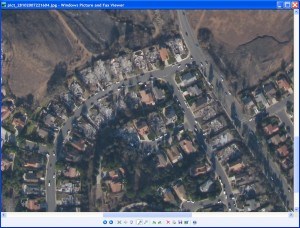Wind continues to fuel the raging Springs Fire, a wildfire that sprung up last week near the coastline north of Los Angeles. About 3,000 homes are in peril, and California State University at Channel Islands ordered evacuations. About 900 firemen have responded to the blaze, which has so far torched 8,000 acres of land covered with dense chaparral and brush.
Dylan Schwilk, a Texas Tech University plant ecologist, studied the effects of wildfires in places such as California, South Africa, Australia and Texas, explains what makes these fires so threatening.
He said this is a winter-rain and summer-drought climate, but the very dry winter and spring this year have left vegetation dry and fire-prone earlier than normal.
Though fire is a natural part of the ecosystem in the area, more fires than usual in recent years have changed the landscape, he said.
According to the plant ecologist, more frequent fires have helped non-native plants thrive and these non-native grasses and weeds have contributed to easily ignitable fuels in some areas.
“As to timing, these fires are early. The natural fire season for chaparral is late summer through autumn. This has been a very dry year, however, and dry vegetation combined with current hot, dry weather have contributed to these early fires. Although these fires are not extraordinarily out of season, winter and spring fires can be especially hard on the native communities and can favor invasive species,” said Schwilk.
Chaparral and coastal sage shrublands, what the media often call “brush,” are naturally prone to relatively infrequent but very intense crown fire.

“Southern California coastal sage scrub and chaparral are fire-prone and, in many respects, fire-dependent ecosystems. That said, many areas in Southern California, especially in the Santa Monica Mountains, have had fires too close together – too many, too frequently. This has actually type-converted native chaparral and coastal sage scrub vegetation to annual grassland dominated by invasive alien species,” Schwilk said.
While the fires are occurring earlier than normal, their intensity is not unnatural or abnormal, he said.
“More and more, former shrublands are being type-converted to annual grassland by frequent fire and those grasses are a flashy fuel that can allow fire to return rapidly, thus acting as a positive feedback. The Springs Fire appears to be burning both through native shrublands as well as some of the areas that too-frequent recent fires have converted to grass and weeds,” the Texas Tech plant ecologist said.
Source: Texas Tech University
Was this article valuable?
Here are more articles you may enjoy.

 Advocacy Groups Ask FIO to Release Homeowners Insurance Data Collected by NAIC
Advocacy Groups Ask FIO to Release Homeowners Insurance Data Collected by NAIC  Texas Accuses Allstate-Owned Arity of Data Privacy Violations
Texas Accuses Allstate-Owned Arity of Data Privacy Violations  Mississippi High Court Tells USAA to Pay up in Hurricane Katrina Bad-Faith Claim
Mississippi High Court Tells USAA to Pay up in Hurricane Katrina Bad-Faith Claim  Amazon Ignored Its Own Worker Safety Studies, Senate Report Says
Amazon Ignored Its Own Worker Safety Studies, Senate Report Says 